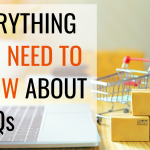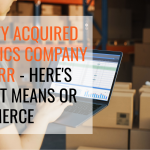When it comes to scaling a business, selling more products and acquiring new customers is crucial for your growth. And one of the best ways that you can reach a larger customer base is none other than selling on multiple online marketplaces.
An online marketplace, as you probably know, is an ecommerce platform or app that facilitates buying and selling between independent sellers and customers. To sell on an online marketplace, a vendor creates an account, opens their webshop, and starts selling their products. The platform takes care of the hosting and payment processing. In some cases, as with Amazon, the marketplace also takes care of order fulfillment, packing, and shipping.
Aside from being a great way to test a business idea, online marketplaces are a fantastic option for small businesses owners who are looking for ways to grow. However, there are also a few risks that come along with selling on these platforms as well.
The competition is fierce, and you might not want to give up a portion of your profits to pay for selling fees. Not to mention, it’s risky. Your entire business is dependent on the platform not freezing your account, and you don’t always own your own customer data either.
In this article, let’s look into the pros and cons of selling on an online marketplace. I’ll also share some of the top online marketplaces where you can sell your products. Let’s dive in now.
Benefits of Selling Via Online Marketplaces
Before diving into unfamiliar territory, always know what you’re getting into. Here are the upsides to selling on online marketplaces:
Access to a Built-In Audience
Online marketplaces spend millions on marketing their site and improving their systems to attract and keep customers. They’ve earned the public’s trust and people don’t think twice about doing business with them.
Attract New, Diverse Customers
Global marketplaces have a reach that independent sellers can only dream of. Selling on an online marketplace might help you discover new markets or customer categories that you didn’t think would be interested in your product.
Easy and Low Cost to Set Up
Building an independent shopping website requires time and money to set up. You need to constantly make sure everything works fast and seamlessly, as broken links or bugs can drastically affect your sales and business reputation. If you want to test the waters of online selling or simply want a channel that’s reliable in case your own website has some technical issues, online marketplaces can be a great solution.
You can easily sign up for a free seller’s account on many online marketplaces. While there are basic requirements you need to comply with, such as personal identity, business documents, and bank information, entry barriers are relatively low and you can start listing products as soon as you meet these requirements.
Analytics and Sales Dashboards
Online marketplaces give sellers access to sales dashboards and shop analytics. You can see which of your listings are the most popular, what keywords people use to find you, and even the times when people are most active in your shop. These are valuable insights that you can use to continuously improve your business.
Entry Point to Finding Your Site
If you’re selling on a marketplace, one of your goals should be to build your brand or products’ reputation. While it’s not always easy to brand your marketplace shop or to lead people to your site from marketplaces, you can still stand out by providing high-quality products and top-notch customer service that will make them remember their buying experience.
Support for Sellers
Many marketplaces have paid marketing or advertising programs that sellers can opt into. These programs help bring in more traffic to their shops or products by boosting visibility through homepage features or product recommendations. Some platforms, like Amazon offer additional support; like Fulfillment by Amazon (FBA), so you can essentially outsource all of the shipping and fulfillment to a third party.
Why a Marketplace Might Not Be Right for Your Online Business
While there are a lot of great benefits to selling through an online marketplace, there are some drawbacks as well:
More Competition
Marketplaces come with their audiences, but this also means more competition for sales. Consider that eBay has 19 million sellers with over 1.5 billion listings and 159 million active buyers worldwide. If you want your online store to do well, you have to learn the ins and outs of the platform you’re selling on. You have to optimize your product listings, keywords, photos, and get consistent five-star reviews so you can stand out from the rest.
Limits Your Price Range
When people come to marketplaces, they will see a lot of products alongside yours. Intense competition may force you to drive prices lower or keep it to a certain range. Some competitors may sell the same product or something closely similar. Unless your product has a unique selling point or comes from a top trusted brand, people tend to make choices based on price.
Warning: If you’re going to be selling on multiple marketplaces, it’s important to have a strategy for managing and monitoring pricing on each platform. They are in competition with each other, so they will often do lightning deals or discounts to try to attract Google’s traffic away from the big guy: Amazon. Amazon monitors this and it could end up causing a price war, in which only YOU would end up losing. Skip the online marketplaces if this is not something you can consistently be on top of.
No Brand Building
When people buy from marketplaces, they often don’t know who exactly they’re buying from. If you’re working on building your brand image or gaining a loyal customer base, remember that it might take some extra work (or could even be impossible) if you sell on an online marketplace.
Amazon, for example, requires sellers to use standardized product listings, Amazon packaging, and limited product inserts. And because you’re basically renting space on a giant platform, you can’t personalize fonts, colors, and widgets on your seller store like you can on your own website.
Seller Support Issues
Most online platforms have policies that are more customer-friendly than seller-friendly. It’s one way of ensuring a great buying experience that encourages people to come back to the website to shop more. For sellers, this means that you have to stick to marketplaces’ return, refund, and order cancellation rules.
Changes In Policies, Algorithm, or Structure
An online marketplace is a platform that you don’t own and sellers are subject to changes that the people in charge decide to make. They may change their rules to accommodate their own profitability. Just when you mastered a platform’s algorithm and SEO, a sudden shift in focus or on their business model might come that could severely impact your own business.
The Risk of Being Frozen
Another risk is that your account could end up getting flagged or frozen, an issue that can cause tremendous loss and a great deal of stress, especially if it’s your primary storefront. Keep in mind that this has happened to many sellers before, and often, support can be slow and these issues can be difficult to resolve.
Fees Eating Into Profits
Seller accounts are usually free, but marketplaces take sales commissions. There are also other fees like listing fees, transaction fees, and payment processing fees depending on the platform you’re on. Pricing can be an issue as you want to be sure you’re not losing money, but you also can’t hike up your prices too much as it can put off potential customers. Unexpected fee increases can also eat into your profits. If you start selling larger quantities, you might feel this impact even more.
Top Ecommerce Marketplaces
There are now over a hundred online marketplaces. Here are some of the most popular online marketplaces that you should know about:
Alibaba
Alibaba is the world’s largest business-to-business (B2B) ecommerce marketplace, giving sellers access to suppliers, manufacturers, and billions of buyers. Yes, it’s open to US sellers now as well. It’s an excellent platform for wholesalers or suppliers looking to sell.
It serves over 200 countries, caters to 40 industries, and gets more than 340,000 product inquiries daily. One of its best features is real-time translation, facilitating communication between buyers and sellers around the globe. They generally have a minimum order value and it’s a great way to sell your products in large quantities.
If you don’t sell wholesale, there’s AliExpress, the business-to-consumer (B2C) arm of the Alibaba group. Aliexpress also dominates the market in China and Asia, and operates worldwide in 220 countries.
(Source: Alibaba)
(Source: AliExpress)
Amazon
Amazon is the most popular online marketplace in the U.S., and one that’s practically synonymous with ecommerce. People even use it as a search engine, with 63% of product searches worldwide starting on their platform. Amazon has an average of 2.7 billion visits each month, which gives ecommerce vendors next-level visibility.
Amazon has over 100 million Prime members who spend an average of $1,400 a year on the platform.
A lot of small businesses who started on Amazon have managed to grow and expand into having their own websites. If used strategically, Amazon can be a great complementary channel to your own website. A wide variety of products are sold on Amazon, such as food, apparel, electronics, home goods, books, videos, and sports goods. There are new and used products on the platform.
Amazon offers fulfillment and shipping options for sellers on the Fulfillment by Amazon program (FBA). The cost to sell depends on which selling plan you take, product category, fulfillment strategy, and other factors. You can take a look into their fee structure here.
(Source: Amazon)
Bonanza
Bonanza is a fast-growing platform “built by entrepreneurs, for entrepreneurs.” Because of this, they understand the challenges that ecommerce merchants face when selling through an online marketplace.
They have lower fees compared to other marketplaces. Listing products individually takes a lot of time, but Bonanza has a nifty feature that allows sellers to easily import listings from other marketplaces like eBay, Amazon, and Etsy. They also give in-depth access to customer analytics, which is crucial if you want to develop customer relationships and get repeat purchases.
(Source: Bonanza)
Café Press
CaféPress is a popular “print on demand” platform that specializes in selling customized mugs, shirts, tote bags, greeting cards, and more. Part of their mission says, “You do the dreaming and we will handle the printing.” Creative entrepreneurs upload their designs and Café Press does the manufacturing, printing and shipping. Café Press sets a base price for each product. Sellers add a markup and get to keep the profits.
Get our Online Marketplaces - Worksheet delivered right to your inbox.
Craigslist
Sometimes, you don’t have to look too far to expand to a new market. If you’ve been selling online globally but not to your local community, you could be missing out on some extra sales. More people are using Facebook Marketplace to sell locally these days, but don’t forget Craigslist.
Craigslist is best-known as a classifieds ads website where you can find everything from merchandise for sale, job opportunities, and real estate. It’s location based and buyers search for items near where they live.
Things that sell well on Craigslist are items like furniture, bikes, car parts, yard or garden gear, electronics, and appliances. Selling on Craigslist is easy and you don’t need to create an account. Since Craigslist is designed for in-person meet ups, they don’t handle shipping or payment processing. Mode of payment is arranged between the buyer and seller.
(Source: Craigslist)
eBay
eBay used to be the go to place to sell second hand items, collectibles, and vintage goods. However, the platform has evolved and now around 80% of the products are new. Sellers have the option to put their items for sale in two ways: there’s the original auction-style, with a starting price and customers bidding on the product, and the second way is to have a fixed price on the listings. eBay is the second most popular retail marketplace in the US and fifth globally, with 187 million active buyers.
(Source: eBay)
Etsy
Etsy is a global online marketplace that sells “one-of-a-kind finds for one-of-a-kind people”. It’s the leading marketplace to sell handcrafted, artisanal goods, originally designed items, and vintage products. Focusing on a niche market helped grow Etsy into an ecommerce giant, making it the 4th most visited marketplace in the U.S. this year.
It’s free to create a seller account on Etsy. They charge a minimal, non-refundable listing fee for each product. There’s also a transaction fee and payment processing fee when a sale is completed.
(Source: Etsy)
Newegg
Do you specialize in gadgets and tech products? You might want to consider selling on Newegg, an ecommerce marketplace that sells new, used, or reconditioned consumer electronic goods and parts. Aside from tech products for gaming and entertainment, they also have home, office, and fitness sections. Top brands like Lenovo, Dell, and Office Depot have seller stores on Newegg, but independent businesses can sell here as well.
A standard account on Newegg is free, but professional and enterprise accounts require payment.
(Source: Newegg)
Overstock
Overstock is a one-stop shop marketplace for home shopping. They sell furniture, sheets, kitchen appliances, home improvement, bed and bath. There’s also a section for kids and babies, health and beauty, apparel, and pet supplies.
Overstock has a partnership with the US government, which is a great opportunity for merchants to sell commercial and technical products in bulk. Unlike eBay or Amazon, only new items can be sold at Overstock. They charge listing fees and sales commission fees. Order fulfillment services are available for sellers who want to spend more time on other aspects of their business.
(Source: Overstock)
Walmart
With around 100 million unique monthly visitors, Walmart is the third most visited marketplace in the US. Third-party sellers can now list on the platform in 35+ product categories. Walmart is a trusted, well-established brand. To protect this reputation, they have a strict vetting process for sellers. Retailers have to request to be a seller and undergo screening and approval.
Walmart has a simple pricing structure that’s straightforward and transparent. There are no monthly or initial setup fees, only a referral fee percentage or commission from sales.
(Source: Walmart)
Wayfair
Wayfair is an online marketplace specializing in furniture and home goods. It’s popular in the United States, Canada, and the United Kingdom, with 31+ million customers and $14 billion in sales in the last 12 months.
Product categories include furniture, bed and bath, decor, rugs, lighting, outdoor, kitchen, and renovation. Unlike other ecommerce platforms, Wayfair doesn’t take sales commissions. Instead, they pay sellers the wholesale cost of the items and Wayfair makes money off the retail price that it sets.
Wayfair arranges and pays for 100% of the shipping costs. They don’t offer warehouse storage and order fulfillment. After a customer purchases a product, Wayfair sends the details to the sellers, who are responsible for packing and shipping orders.
(Source: Wayfair)
Wish
Wish is a mobile-first marketplace that’s active in 100+ countries with over 300 million customers. You can sell a variety of budget-friendly products ranging from apparel, accessories, home decor, to gadgets. There are no registration and listing fees, and only a sales commission is charged.
Wish is unique from other platforms that suggest recommendations based on users’ searches. It uses data from Facebook and Google to curate their recommendations, making their product feed more attractive to the user. They also use some gamification strategies in their platform to entice users to click and to encourage engagement.
(Source: Wish)
Rakuten
Rakuten is an online retailer that originated in Japan and now serves 1.5 global members. Products on the site range from apparel, electronics, and even vacations. Customer service and inventory for the are handled by the vendors, giving you more control over inventory and logistics. Rakuten feels like a virtual mall hosting many different sites, as sellers have more flexibility to customize the look of their shop.
Rakuten charges a monthly fee, listing fee, and a commission charge. These come with added benefits such as dedicated seller support, unlimited advertising, online training, and participation in their Pro events.
(Source: Rakuten)
Zazzle
Zazzle is an on-demand marketplace where creative entrepreneurs can sell their art or photography on-demand. Makers can also sell clothing, phone cases, mugs, and other items with their designs. Like Café Press, the seller simply provides the designs, and Zazzle takes care of the manufacturing and shipping. Makers earn through royalties and are free to set how much they want to earn. However, higher royalty fees also get charged higher sales transaction fees.
Zazzle’s print-on-demand service is particularly popular among those looking for event invitations and customized napkins.
(Source: Zazzle)
Specialty Marketplaces
Finally, when it comes to selling on online marketplaces, another great option is to go niche. Specialty online marketplace gives you access to a very specific audience. If you’re on a site that’s more niche and is associated with a certain category, it’s an even better way to attract leads that convert.
Think of Houzz for home goods, or Chewy for pet products. Niche marketplaces are an excellent way to reach your target audience.
Selling on an online marketplace is a great complementary sales channel to your own website. It’s a new way to reach customers, get more monthly traffic, and earn more sales. While it might seem like a low-cost way to increase your profits, you need to invest time and effort to learn how the platform works to make the most of it.
So how can you determine which platform to use? Start by considering the platform’s target audience, customer support, brand reputation, fee structure, and seller support. You’ll also want to Google reviews for the platform as well, to see what sellers think about it.
A platform that’s rated too low or isn’t well known, probably isn’t worth using. Consider also whether you have time to maintain a careful pricing strategy. If not, then it’s probably not worth using a marketplace and you’re better off selling directly from your website.
Looking for help scaling your ecommerce website? Reach out now for your FREE 20-minute consultation call. Let’s find the best solutions to grow, and fast.
Get our Online Marketplaces - Worksheet delivered right to your inbox.







